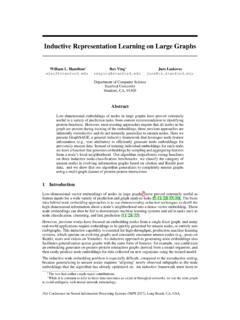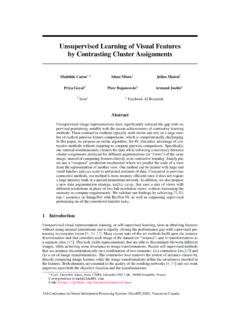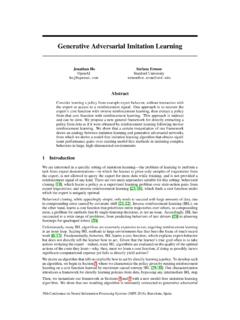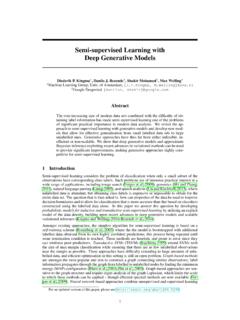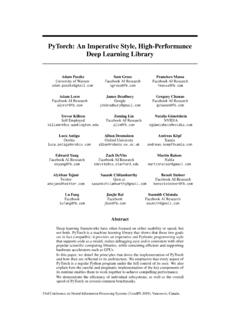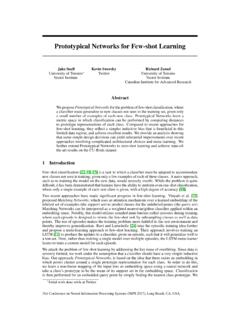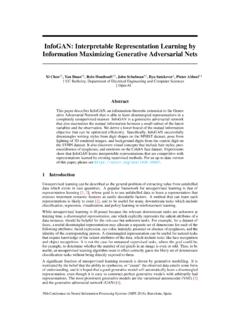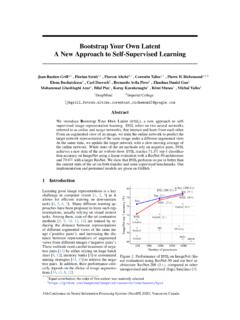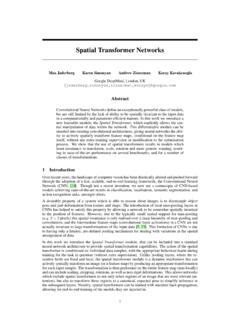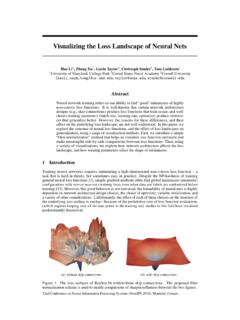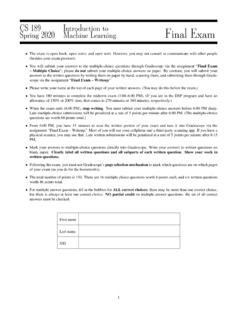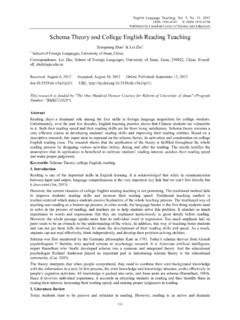Transcription of PointNet++: Deep Hierarchical Feature Learning on Point ...
1 pointnet ++: deep Hierarchical Feature Learning onPoint Sets in a Metric SpaceCharles R. Qi Li Yi Hao Su Leonidas J. GuibasStanford UniversityAbstractFew prior works study deep Learning on Point sets. pointnet [20] is a pioneer in thisdirection. However, by design pointnet does not capture local structures induced bythe metric space points live in, limiting its ability to recognize fine-grained patternsand generalizability to complex scenes. In this work, we introduce a hierarchicalneural network that applies pointnet recursively on a nested partitioning of theinput Point set. By exploiting metric space distances, our network is able to learnlocal features with increasing contextual scales. With further observation that pointsets are usually sampled with varying densities, which results in greatly decreasedperformance for networks trained on uniform densities, we propose novel setlearning layers to adaptively combine features from multiple scales.
2 Experimentsshow that our network called pointnet ++ is able to learn deep Point set featuresefficiently and robustly. In particular, results significantly better than state-of-the-arthave been obtained on challenging benchmarks of 3D Point IntroductionWe are interested in analyzing geometric Point sets which are collections of points in a Euclideanspace. A particularly important type of geometric Point set is Point cloud captured by 3D scanners, , from appropriately equipped autonomous vehicles. As a set, such data has to be invariant topermutations of its members. In addition, the distance metric defines local neighborhoods that mayexhibit different properties. For example, the density and other attributes of points may not be uniformacross different locations in 3D scanning the density variability can come from perspective effects,radial density variations, motion, prior works study deep Learning on Point sets.
3 pointnet [20] is a pioneering effort that directlyprocesses Point sets. The basic idea of pointnet is to learn a spatial encoding of each Point and thenaggregate all individual Point features to a global Point cloud signature. By its design, pointnet doesnot capture local structure induced by the metric. However, exploiting local structure has proven tobe important for the success of convolutional architectures. A CNN takes data defined on regulargrids as the input and is able to progressively capture features at increasingly larger scales along amulti-resolution hierarchy. At lower levels neurons have smaller receptive fields whereas at higherlevels they have larger receptive fields. The ability to abstract local patterns along the hierarchyallows better generalizability to unseen introduce a Hierarchical neural network, named as pointnet ++, to process a set of points sampledin a metric space in a Hierarchical fashion.
4 The general idea of pointnet ++ is simple. We firstpartition the set of points into overlapping local regions by the distance metric of the underlyingspace. Similar to CNNs, we extract local features capturing fine geometric structures from smallneighborhoods; such local features are further grouped into larger units and processed to producehigher level features. This process is repeated until we obtain the features of the whole Point Conference on Neural Information Processing Systems (NIPS 2017), Long Beach, CA, design of pointnet ++ has to address two issues: how to generate the partitioning of the Point set,and how to abstract sets of points or local features through a local Feature learner. The two issuesare correlated because the partitioning of the Point set has to produce common structures acrosspartitions, so that weights of local Feature learners can be shared, as in the convolutional setting.
5 Wechoose our local Feature learner to be pointnet . As demonstrated in that work, pointnet is an effectivearchitecture to process an unordered set of points for semantic Feature extraction. In addition, thisarchitecture is robust to input data corruption. As a basic building block, pointnet abstracts sets oflocal points or features into higher level representations. In this view, pointnet ++ applies PointNetrecursively on a nested partitioning of the input 1: Visualization of a scan captured from aStructure Sensor (left: RGB; right: Point cloud).One issue that still remains is how to generateoverlapping partitioning of a Point set. Eachpartition is defined as a neighborhood ball inthe underlying Euclidean space, whose param-eters include centroid location and scale. Toevenly cover the whole set, the centroids are se-lected among input Point set by a farthest pointsampling (FPS) algorithm.
6 Compared with vol-umetric CNNs that scan the space with fixedstrides, our local receptive fields are dependenton both the input data and the metric, and thus more efficient and the appropriate scale of local neighborhood balls, however, is a more challenging yetintriguing problem, due to the entanglement of Feature scale and non-uniformity of input pointset. We assume that the input Point set may have variable density at different areas, which is quitecommon in real data such as Structure Sensor scanning [18] (see Fig. 1). Our input Point set is thusvery different from CNN inputs which can be viewed as data defined on regular grids with uniformconstant density. In CNNs, the counterpart to local partition scale is the size of kernels. [25] showsthat using smaller kernels helps to improve the ability of CNNs. Our experiments on Point set data,however, give counter evidence to this rule.
7 Small neighborhood may consist of too few points due tosampling deficiency, which might be insufficient to allow PointNets to capture patterns significant contribution of our paper is that pointnet ++ leverages neighborhoods at multiple scalesto achieve both robustness and detail capture. Assisted with random input dropout during training,the network learns to adaptively weight patterns detected at different scales and combine multi-scalefeatures according to the input data. Experiments show that our pointnet ++ is able to process pointsets efficiently and robustly. In particular, results that are significantly better than state-of-the-art havebeen obtained on challenging benchmarks of 3D Point Problem StatementSuppose thatX=(M, d)is a discrete metric space whose metric is inherited from a Euclidean spaceRn, whereM Rnis the set of points anddis the distance metric.
8 In addition, the density ofMin the ambient Euclidean space may not be uniform everywhere. We are interested in Learning setfunctionsfthat take suchXas the input (along with additional features for each Point ) and produceinformation of semantic interest regradingX. In practice, suchfcan be classification function thatassigns a label toXor a segmentation function that assigns a per Point label to each member MethodOur work can be viewed as an extension of pointnet [20] with added Hierarchical structure. Wefirst review pointnet (Sec. ) and then introduce a basic extension of pointnet with hierarchicalstructure (Sec. ). Finally, we propose our pointnet ++ that is able to robustly learn features even innon-uniformly sampled Point sets (Sec. ).2sampling & groupingpointnetset abstraction38interpolateskip link concatenationpointnetsampling & groupingpointnetinterpolateunit pointnetunit pointnetfully connected layersset abstractionSegmentationClassificationHie rarchical Point set Feature learningclass scoresper- Point scores(N,d+C)(1,C4)(k)(N1,K,d+C)(N1,d+C1 )(N2,K,d+C1)(N2,d+C2)(N1,d+C2+C1)(N1,d+C 3)(N,d+C3+C)(N,k)Figure 2: Illustration of our Hierarchical Feature Learning architecture and its application for setsegmentation and classification using points in 2D Euclidean space as an example.
9 Single scale pointgrouping is visualized here. For details on density adaptive grouping, see Fig. Review of pointnet [20]: A Universal Continuous Set Function ApproximatorGiven an unordered Point set{x1,x2,..,xn}withxi2Rd, one can define a set functionf:X!Rthat maps a set of points to a vector:f(x1,x2,..,xn)= MAXi=1,..,n{h(xi)} (1)where andhare usually multi-layer perceptron (MLP) set functionfin Eq. 1 is invariant to input Point permutations and can arbitrarily approximate anycontinuous set function [20]. Note that the response ofhcan be interpreted as the spatial encoding ofa Point (see [20] for details). pointnet achieved impressive performance on a few benchmarks. However, it lacks the ability tocapture local context at different scales. We will introduce a Hierarchical Feature Learning frameworkin the next section to resolve the Hierarchical Point Set Feature LearningWhile pointnet uses a single max pooling operation to aggregate the whole Point set, our newarchitecture builds a Hierarchical grouping of points and progressively abstract larger and larger localregions along the Hierarchical structure is composed by a number ofset abstractionlevels (Fig.)
10 2). At each level, aset of points is processed and abstracted to produce a new set with fewer elements. The set abstractionlevel is made of three key layers:Sampling layer,Grouping layerandPointNet layer. TheSamplinglayerselects a set of points from input points, which defines the centroids of local constructs local region sets by finding neighboring points around the a mini- pointnet to encode local region patterns into Feature set abstraction level takes anN (d+C)matrix as input that is fromNpoints withd-dimcoordinates andC-dim Point Feature . It outputs anN0 (d+C0)matrix ofN0subsampled pointswithd-dim coordinates and newC0-dim Feature vectors summarizing local context. We introduce thelayers of a set abstraction level in the following input points{x1,x2,..,xn}, we use iterative farthest Point sampling (FPS)to choose a subset of points{xi1,xi2.}
